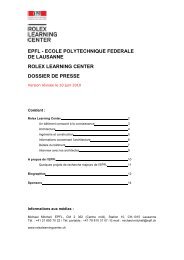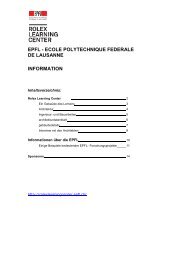press kit - Rolex Learning Center | EPFL
press kit - Rolex Learning Center | EPFL
press kit - Rolex Learning Center | EPFL
Create successful ePaper yourself
Turn your PDF publications into a flip-book with our unique Google optimized e-Paper software.
An interview with the architects, Kazuyo Sejima + Ryue Nishizawa<br />
What was the process that led to your final design?<br />
The Library, multipurpose hall, café, and many other different programs were stacked to make a tall<br />
multi-storey tower in our first studies. But finally, as the program defined a meeting place for students<br />
engaged in many fields of study we felt that everything on one floor and in one room was best. We did<br />
not make a normal one-room space but incorporated patios and topography to organise the program<br />
such that each is separated and connected at the same time. The large one-room space undulates up<br />
and down creating an open space under the building so that people can walk to the center of the building.<br />
This enabled us to make one main entrance at the center of the building.<br />
What were your influences and inspiration for the design?<br />
It is not that we had a particular shape in mind. We arrived at what we thought was the most appropriate<br />
shape by studying the required program and the relationships between individual parts. In other words,<br />
we asked ourselves: what kind of space can a lot of people, doing different activities at the same time,<br />
enjoy being in? After we had the final shape, we used stairs and ramps from Lausanne and the Swiss<br />
landscape as precedents to learn how the gentle slopes can be used and enjoyed.<br />
What do you think good architecture can contribute to the process of learning?<br />
The whole program is located in a one-room space, where people studying one topic might become<br />
interested in another because the space is very open and connected. We imagined that this type of<br />
open space might increase the possibility for new meetings or trigger new activities. In comparison to<br />
traditional study spaces, where corridors and classrooms are clearly separated, we hope that there will<br />
be many different ways to use the new space and that there will be more active interaction, which in turn<br />
will trigger new activities.<br />
The <strong>Rolex</strong> <strong>Learning</strong> <strong>Center</strong> is a highly innovative building. Can you tell us about the client’s original<br />
brief?<br />
This education center, made up of a library, multipurpose hall, café, restaurant and offices is a central<br />
element in the campus plan, not only the <strong>EPFL</strong> plan but also the adjacent university plan. Unlike a traditional<br />
library, the client wanted to create a new type of space where many different fields of study exchange<br />
knowledge freely and easily.<br />
Could you describe some of the technical challenges involved in realising it?<br />
The long span shells in the structure; the 3-dimensional topography and its relationships to the program;<br />
realising a building made outside of Japan; the arrangement of slopes, stairs, and the inclined elevator<br />
were some of the challenges.<br />
The topography of the <strong>Rolex</strong> <strong>Learning</strong> <strong>Center</strong> is unique. Can you talk about the human experience<br />
of inhabiting it might be like and how people might use it?<br />
This building has both architectural and topographical qualities so the experiences will be diverse. The<br />
act of entering or exiting a room, or studying at a desk might be an architectural experience but to crisscross<br />
a slope, or to climb it with the funicular-like inclined elevator might be an experience closer to<br />
being on a hill outdoors. Also, the topography created by the architecture will induce architectural experiences<br />
that have not been felt in traditional buildings. When standing on top of the hill, you might not<br />
see the other hill but might hear faint voices, or you might not be able to see the other place but your<br />
body can sense there is a connection to another space. Unlike traditional one-room spaces, new relationships<br />
will emerge and we hope this will create a new type of architectural experience.<br />
How does the <strong>Rolex</strong> <strong>Learning</strong> <strong>Center</strong> relate to its location – to the geography and climate of Lausanne?<br />
An access road wraps the site on all four sides, which is surrounded by the existing campus, with the<br />
lake to the south. The <strong>Rolex</strong> <strong>Learning</strong> <strong>Center</strong> is open to all sides so people can access the building from<br />
any direction. The landscape created inside of the building is in a continuum with the landscape of the<br />
campus and the city.<br />
What are your hopes for the future users of your building, and their enjoyment of this extraordinary<br />
place?<br />
The building is not traditional, but new, so we hope that the people will use it in a new and original way.<br />
What attracted you to the idea of working on a building devoted to learning about science and<br />
engineering as opposed to other uses such as museum, gallery or domestic spaces?<br />
We were excited by the opportunity to think about spaces where people meet, study, and create entirely<br />
new sets of knowledge.<br />
9





